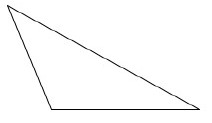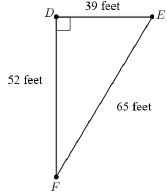General Information
Benchmark Instructional Guide
Connecting Benchmarks/Horizontal Alignment
Terms from the K-12 Glossary
- Algorithm
- Area
- Rectangle
- Triangle
Vertical Alignment
Previous Benchmarks
Next Benchmarks
Purpose and Instructional Strategies
Students will use their understanding from grade 5 of models and formulas to find the area of a rectangle to derive the formula to find the area of a triangle (MTR.1.1, MTR.2.1). Students will extend this knowledge in grade 7 to decompose composite figures into triangles and quadrilaterals in order to find area.- Instruction includes developing the understanding that two copies of any right triangle will always form a rectangle with the same base and height. Therefore, the triangle has an area of half of the rectangle, = ( × ). This understanding can develop from seeing how a triangle is constructed when cutting a rectangular piece of paper diagonally in half.
- Students should be flexible in their understanding of formulas to be able to use show the equivalency of and .
- Formulas can be a tool or strategy for geometric reasoning. Students require a solid understanding of two area concepts: (1) the area of a rectangle is × or × , and (2) figures of the same size and shape (congruent) have the same area.
- Instruction includes representing measurements for area as square units, units squared or units2.
- Students should understand that any side of the triangle can be a base; however, the height can only be represented as a line segment drawn from a vertex perpendicular to the base. The terms height and altitude can be used interchangeably. Students should see the right-angle symbol,
 to indicate perpendicularity.
to indicate perpendicularity. - Problem types include having students’ measure lengths using a ruler to determine the area.
Common Misconceptions or Errors
- Students may forget that multiplying by and dividing by are the same operation.
- Students may neglect to apply the when finding the area of a triangle.
- Students may incorrectly identify a side measurement as the height of a triangle.
Strategies to Support Tiered Instruction
- Teacher models several problems solving them both ways (using a rectangle and using a formula) and then have the students solve them step by step guiding them to the answer. This will provide students with the opportunity to see that the two operations are identical.
- Teacher reinforces that a right triangle is half of a rectangle, therefore we must cut the area in half.
- Teacher models with geometric software so students can see that a right triangle is half of a rectangle, which is why we multiply by .
- Teacher models the use of manipulatives that students can measure to better understand there is a difference between a side length and the height in non-right triangles.
Instructional Tasks
Instructional Task 1 (MTR.2.1, MTR.4.1)Mrs. Lito asked her students to label a base and its corresponding height in the triangle shown.


- Part A. Which students, if any, have correctly identified a base and its corresponding height? Which ones have not? Explain what is incorrect.
- Part B. There are three possible base-height pairs for this triangle. Sketch all three.
Instructional Task 2 (MTR.5.1)
Look at the triangles below.

- Which triangle has the greatest area?
- Which triangle has the least area?
- Do any of the triangles have the same area?
- Are some areas impossible to compare?
Instructional Items
Instructional Item 1Find the area of Δ.

*The strategies, tasks and items included in the B1G-M are examples and should not be considered comprehensive.
